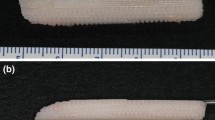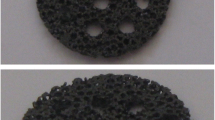Abstract
Although many graft materials have been used for augmentation rhinoplasty, an ideal graft has not yet been developed. As the field of tissue engineering has been developing, it has been applied to the reconstruction of many organs, but its application in the rhinoplasty field is still limited. This study evaluated the utility of allogenic chondrocytes with fibrin/hyaluronic acid (HA)–poly(l-lactic-co-glycolic acid) (PLGA) constructs in augmentation rhinoplasty. Chondrocytes from rabbit auricular cartilage were isolated and cultured with fibrin/HA hydrogels and implanted into PLGA scaffolds. After 8 weeks of in vitro culture, the scaffolds were implanted in the nasal dorsum of six rabbits. Eight weeks postoperatively, the implanted sites were evaluated with gross, radiologic, and histologic analysis. In vitro, more than 90% of the seeded chondrocytes in the PLGA scaffolds survived for 2 weeks, and they produced a large amount of extracellular matrix and were well differentiated. The grafts maintained their initial shape for 8 weeks after implantation. Radiological and histological evaluations showed that the structure was well maintained with minimal inflammatory response and appropriate elevation levels. However, the formation of neo-chondrocytes was not observed. PLGA scaffolds seeded with fibrin/HA and allogenic chondrocytes can be a biocompatible augmentation material in rhinoplasty in the future.






Similar content being viewed by others
References
Ahn JM. The current trend in augmentation rhinoplasty. Facial Plast Surg. 2006;22:61–9.
Sajjadian A, Naghshineh N, Rubinstein R. Current status of grafts and implants in rhinoplasty: part II. Homologous grafts and allogenic implants. Plast Reconstr Surg. 2010;125:99e–109.
Sajjadian A, Rubinstein R, Naghshineh N. Current status of grafts and implants in rhinoplasty: part I. Autologous grafts. Plast Reconstr Surg. 2010;125:40e–9.
Berghaus A, Stelter K. Alloplastic materials in rhinoplasty. Curr Opin Otolaryngol Head Neck Surg. 2006;14:270–7.
Trautvetter W, Kaps C, Schmelzeisen R, Sauerbier S, Sittinger M. Tissue-engineered polymer-based periosteal bone grafts for maxillary sinus augmentation: five-year clinical results. J Oral Maxillofac Surg. 2011;69:2753–62.
Mouzopoulos G, Siebold R. Partial meniscus substitution with tissue-engineered scaffold: an overview. Clin Sports Med. 2012;31:167–81.
Berg M, Ejnell H, Kovács A, Nayakawde N, Patil PB, Joshi M, et al. Replacement of a tracheal stenosis with a tissue-engineered human trachea using autologous stem cells: a case report. Tissue Eng Part A. 2014;20:389–97.
Lee SJ, Broda C, Atala A, Yoo JJ. Engineered cartilage covered ear implants for auricular cartilage reconstruction. Biomacromolecules. 2011;12:306–13.
Javad T. Tissue engineering of the intervertebral disc’s annulus fibrosus: a scaffold-based review study. Tissue Eng Regen Med. 2017;14:81–91.
Rothan HA, Mahmod SA, Djordjevic I, Golpich M, Yusof R, Snigh S. Polycaprolactone triol–citrate scaffolds enriched with human platelet releasates promote chondrogenic phenotype and cartilage extracellular matrix formation. Tissue Eng Regen Med. 2017;14:93–101.
Jin GZ, Kim HW. Effects of type I collagen concentration in hydrogel on the growth and phenotypic expression of rat chondrocytes. Tissue Eng Regen Med. 2017;14:383–91.
Kim YS, Park DY, Cho YH, Chang JW, Choi JW, Park JK, et al. Cultured chondrocyte and porcine cartilage-derived substance (PCS) construct as a possible dorsal augmentation material in rhinoplasty: a preliminary animal study. J Plast Reconstr Aesthet Surg. 2015;68:659–66.
Koch RJ, Gorti GK. Tissue engineering with chondrocytes. Facial Plast Surg. 2002;18:59–68.
Farhadi J, Jaquiery C, Haug M, Pierer G, Zeilhofer HF, Martin I. Bone and cartilage tissue engineering for facial reconstructive surgery. IEEE Eng Med Biol Mag. 2006;25:106–9.
Rotter N, Haisch A, Bücheler M. Cartilage and bone tissue engineering for reconstructive head and neck surgery. Eur Arch Otorhinolaryngol. 2005;262:539–45.
Hong HJ, Chang JW, Park JK, Choi JW, Kim YS, Shin YS, et al. Tracheal reconstruction using chondrocytes seeded on a poly(L-lactic-co-glycolic acid)-fibrin/hyaluronan. J Biomed Mater Res A. 2014;102:4142–50.
Somekawa S, Mahara A, Masutani K, Kimura Y, Urakawa H, Yamaoka T. Effect of thermoresponsive poly(L-lactic acid)- poly(D-ethylene glycol) gel injection on left ventricular remodeling in a rat myocardial infarction model. Tissue Eng Regen Med. 2017;14:507–16.
Hong HJ, Lee JS, Choi JW, Min BH, Lee HB, Kim CH. Transplantation of autologous chondrocytes seeded on a fibrin/hyaluronan composite gel into tracheal cartilage defects in rabbits: preliminary results. Artif Organs. 2012;36:998–1006.
Daudt DR 3rd, Mueller B, Park YH, Wen Y, Yorio T. Methylene blue protects primary rat retinal ganglion cells from cellular senescence. Investig Ophthalmol Vis Sci. 2012;53:4657–67.
Lam SM. Asian rhinoplasty. Semin Plast Surg. 2009;23:215–22.
Hong JP, Yoon JY, Choi JW. Are polytetrafluoroethylene (Gore-Tex) implants an alternative material for nasal dorsal augmentation in Asians? J Craniofac Surg. 2010;21:1750–4.
Yanaga H, Koga M, Imai K, Yanaga K. Clinical application of biotechnically cultured autologous chondrocytes as novel graft material for nasal augmentation. Aesthet Plast Surg. 2004;28:212–21.
Han SK, Shin SH, Kang HJ, Kim WK. Augmentation rhinoplasty using injectable tissue-engineered soft tissue: a pilot study. Ann Plast Surg. 2006;56:251–5.
Vinatier C, Gauthier O, Masson M, Malard O, Moreau A, Fellah BH, et al. Nasal chondrocytes and fibrin sealant for cartilage tissue engineering. J Biomed Mater Res A. 2009;89:176–85.
Choi JW, Choi BH, Park SH, Pai KS, Li TZ, Min BH, et al. Mechanical stimulation by ultrasound enhances chondrogenic differentiation of mesenchymal stem cells in a fibrin–hyaluronic acid hydrogel. Artif Organs. 2013;37:648–55.
Yang CL, Chen HW, Wang TC, Wang YJ. A novel fibrin gel derived from hyaluronic acid-grafted fibrinogen. Biomed Mater. 2011;6:025009.
Park SH, Cui JH, Park SR, Min BH. Potential of fortified fibrin/hyaluronic acid composite gel as a cell delivery vehicle for chondrocytes. Artif Organs. 2009;33:439–47.
Pan Z, Ding J. Poly(lactide-co-glycolide) porous scaffolds for tissue engineering and regenerative medicine. Interface Focus. 2012;2:366–77.
Wu L, Ding J. Effects of porosity and pore size on in vitro degradation of three-dimensional porous poly(d, l-lactide-co-glycolide) scaffolds for tissue engineering. J Biomed Mater Res A. 2005;75A:767–77.
Xue D, Zheng Q, Zong C, Li Q, Li H, Qian S, et al. Osteochondral repair using porous poly(lactide-co-glycolide)/nano-hydroxyapatite hybrid scaffolds with undifferentiated mesenchymal stem cells in a rat model. J Biomed Mater Res A. 2010;94A:259–70.
Murphy WL, Kohn DH, Mooney DJ. Growth of continuous bonelike mineral within porous poly(lactide-co-glycolide) scaffolds in vitro. J Biomed Mater Res. 2000;50:50–8.
Acknowledgements
This research was supported by a grant from the Korea Health Technology R&D Project through the Korea Health Industry Development Institute (KHIDI), funded by the Ministry of Health & Welfare, Republic of Korea (Grant Number: HI14C2108).
Author information
Authors and Affiliations
Corresponding author
Ethics declarations
Conflicts of interest
The authors have declared no conflicts of interest.
Ethical statement
This study was conducted under the approval of the Institutional Animal Experiment Committee at Ajou University School of Medicine (IACUC number: 2017-0023).
Rights and permissions
About this article
Cite this article
Won, HR., Kim, Y.S., Won, JE. et al. The Application of Fibrin/Hyaluronic Acid–Poly(l-Lactic-co-Glycolic Acid) Construct in Augmentation Rhinoplasty. Tissue Eng Regen Med 15, 223–230 (2018). https://doi.org/10.1007/s13770-017-0095-5
Received:
Revised:
Accepted:
Published:
Issue Date:
DOI: https://doi.org/10.1007/s13770-017-0095-5




